Goldfields
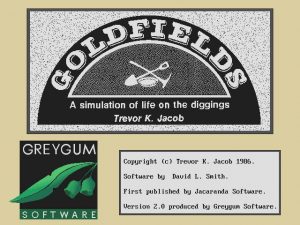 Game Meta:
Game Meta:“Goldfields” is a simulation of a nineteenth century gold rush. It is designed to give students a “feel” for the social history of the gold rushes.
As a player, you are a recent, penniless arrival to Suze Port. To succeed in the game, you must survive the long and dangerous walk to the gold fields and then you have to become wealthy within one year. You can make your fortune in many different ways, including trying different kinds of mining, such as cradle and panning. Obstacles in the game include mine shafts that collapse, which can lead to you losing money while you’re spending time in hospital. Other methods of making money include getting a job, becoming a shareholder in several companies, or becoming a thief.
A review of the game published in the “Australian Journal of Reading” in 1988 applauds the success of the simulation in transporting students to the life and times of the goldrush era. The review continues that although the games was created for use in social studies it has further application across the curriculum in as it offers skills in ‘note taking, creative writing, art, drama and basic arithmetic. The ability of the software to support and encourage group work is also praised. The review ends by stating “The designers of Goldfields deserve full credit for effectively utilising the potential of the microcomputer and for the imaginative accompanying material.” Reference: “Australian Journal of Reading”, 1988, Vol 9, Issue 4, p. 268.
“Goldfields” is a one-player game, and the primary control is Joystick Port 2.
The software came packaged with teacher’s guides and classroom activities.
A copy of the boxed software is held in the Queensland University of Technology, Central Library, and includes the following items:
- 1 object program, on 1 disc (5 1/4 in.), teacher’s guide, 4 paper masters, 1 vol.
- 1 disk (Commodore 64 or 128) + journal + 3 sheets + teacher’s guide.
- 1 disk (Apple family) ; 5 1/4 in. + +A Goldfields Journal (25 p. ; ill., 19cm.) + 4 sheets + teachers guide.
A book by Sue Rowe entitled “A Lode of Bullion: (Australia’s gold era)” was available to schools to accompany Jacaranda’s software. A copy of this book is held by the State Library of Queensland.
Version information:
The Apple II version of “Goldfields” was programmed by Gerald Wluka and the DOS version was programmed by Steve Luckett. The original Mac version (HyperCard) was programmed by Bruce Mitchell, with later Mac versions programmed by Steve Luckett.
Version 2.0 was produced by Greygum Software.

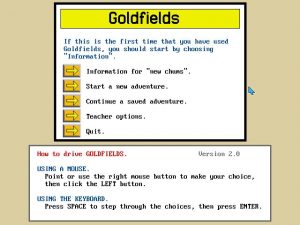
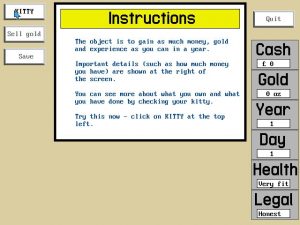
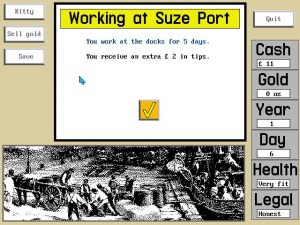
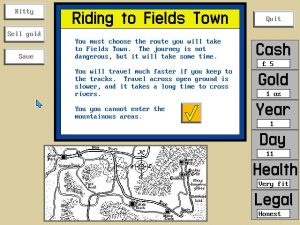
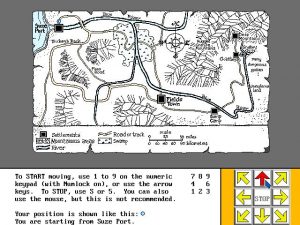
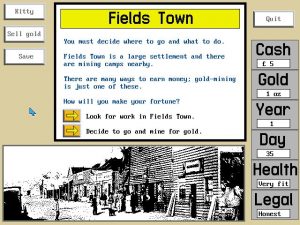
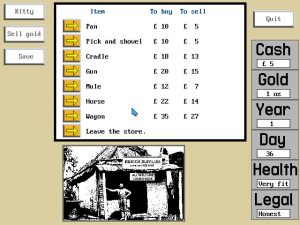
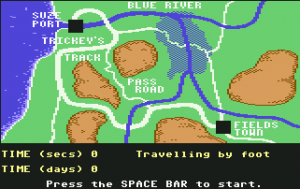
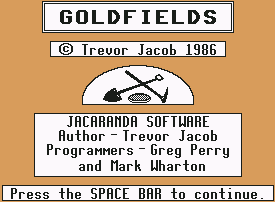
Just a tiny typo there: the game starts at Suze Port, not Suez. The name Suze was chosen by the author, Trevor Jacob. We always feared that transposition would happen somewhere, sometime, but it took a while!
Thanks Bruce. Fixed now.
I was at St Joseph’s College Nudgee Junior in Brisbane in the early 90s, and this game was a beloved part of the history classes for year 4 and 5 students.
Where can I download this game? Without doing a game review… 🙁
Goldfields is a title that has not been abandoned and is still being actively sold. You can purchase this title (I’ll bet there aren’t a lot of software titles that are still being sold close to 30 years from their release). Refer to the following URL.
http://www.greygum.com.au/nebula/index.php/goldfields
how do we play this game?
ps meow
WOAH .. $104.50 just to but a single license that’s kinda steep for a game that’s decades old, this game has been in the back of my mind to want to play again for the better part of 20 years, I finally find the actual name, then find out the cost…
Disgraceful that educational software (or any software) would remain so expensive after 30 odd years, when most (if not all) other games are now free.
Admittedly it is a little pricey, but in its defence the software does come very well packaged and nicely presented; almost retro-style. It has been a long time since I have seen software presented as well as this title is. Consider this comment as a bit of a review of the physical package.
The package is one of those VCR-type black plastic cases, a bit larger than A5 sized but about 2cm thick, so the media itself is very well protected from casual knocks and bumps. In fact thinking about it now, this is probably the same type of packaging that would have been used for the original 5.25 floppy titles. The packaging reminds me of a hardcover book.
The CD itself appears to have just a direct-printed label and is stored in the modern-style clear plastic sleeve, so nothing extraordinary about that.
Assorted documentation (all in black and white) includes:
-folded A4 sheet of quick-start installation instructions,
-set of four A4 folded sheets (obviously intended to be photocopied by teachers to hand out to students) comprising of a Diary page, Share Certificates page, a Map and a page of spelling words related to the title (eg. alluvial, blacksmith, cradle, damper, dysentery, etc).
-an A5 booklet (with card-style paper for the cover) Teacher’s Guide.
-a slightly smaller than A5 booklet titled “A Goldfields Journal” (with beautiful thin card-style rippled-texture paper for the cover), obviously intended to be read by the students.
I really, really loved the presentation of “A Goldfields Journal” and it struck me as being special when I first opened the package – too nice to be handed around a classroom. It reminded of the state and style of documentation used back in the 1980’s. I think one of the Apple Users Groups (was it Sydney AUG maybe) use to publish periodicals with the same style of cover back in the 1980’s. The Journal itself is about 24 pages of text and dotted with an occasional greyscale image of historic photographs. The text covers various aspects of life in Goldfields, with a few paragraphs dedicated to each of the main components of the title (eg. Suze Port, Information for Travellers, Licenses and License Dodging, Health, etc).
But the retro doesn’t stop there. Opening the Teacher’s Guide booklet to the table of contents shows that page 1 contains installation notes for Apple II, Acorn and BBC. In fact there is a special note opposite the Contents page titled, “Vintage Software, but new installation instructions”. It says that the publication is essentially unaltered since it was first written and even though versions for these older platforms are no longer produced, the documentation has been left as is for historical interest. Many memories were revived just by reading through that first page and I am glad they have chosen to leave these now obsolete instructions there.
The Teacher’s Guide itself contains “suggested activities” for students and classroom use and is aimed towards, “primary and lower secondary” students.
So the question now is, is it worth it? Well, that depends on you.
In a physical sense alone, it isn’t worth that much despite the high quality of the packaging (by todays standards).
If you are only after the software for personal entertainment purposes, then yes, “ouch” might be a suitable response.
If you are after the software for family educational purposes, outright recognise the effort that has taken place to assemble the title and are prepared to pay a premium for Australian software, then it is probably worth it. I wonder if it could be claimed as an educational expense or something like that for taxation purposes (I don’t know).
If you are after a retro experience, are a collector or want to own a piece of Australian software history, then I think you would find value in the purchase of this title.
Pingback: Game Review- Goldfields | kkatlas
I think I may still have a boxed version of this on Commodore 64 in storage. You may like to add the C64 version to your list above. Verified here: http://www.gamebase64.com/game.php?id=3212&d=45
Thanks Dan. Have added Commodore 64. Can you recall what other Australian games you have in your collection? Would you like to share anything about your collection or about what you playd / made on C64 as a blog post?
how do u play the goldfirlds game???
plz tell me
Pingback: Gamification is [not] bulls**t. Or is it? | Hannah Ranson
where can i play the game again
Hi, trying to find the name of a com64 game where , you would start a small village with bakers, blacksmith etc, send surveyors out to find gold, coal etc then send out minors to mine it.
Then you would send you army out to fight your neighbour and you would watch you troops try to take his village then just keep going.
I cannot remember this game name for the life of me even though I played it for many days on end.
thanks for your help.
ps wish I had kept my 64.